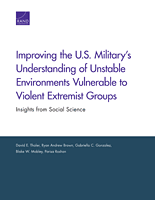| 来源类型 | Research Reports
|
| 规范类型 | 报告
|
| ISBN | 9780833081643
|
| 来源ID | RR-298-A
|
| Improving the U.S. Military's Understanding of Unstable Environments Vulnerable to Violent Extremist Groups: Insights from Social Science |
| David E. Thaler; Ryan Andrew Brown; Gabriella C. Gonzalez; Blake W. Mobley; Parisa Roshan
|
| 发表日期 | 2013
|
| 出版年 | 2013
|
| 页码 | 116
|
| 语种 | 英语
|
| 结论 |
The Research Team Identified 12 Underlying Factors Relevant to Unstable Environments Prone to Violent Extremism from Anthropology, Sociology, Political Science, and Related Fields- Factor 1: The level of external support for violent extremist groups
- Factor 2: The extent to which the government is considered illegitimate or ineffective by the population
- Factor 3: The presence of tribal or ethnic indigenous populations with a history of resisting state rule
- Factor 4: The levels of poverty and inequality
- Factor 5: The extent to which local governance is fragmented, weak, or vulnerable
- Factor 6: The existence of ungoverned space
- Factor 7: The presence of multiple violent, nonstate groups competing for power
- Factor 8: The level of government restriction on political or ideological dissent
- Factor 9: The level of consistency and/or agreement between a violent extremist group's goals and the ideology of target populations
- Factor 10: The extent to which population and extremist groups perceive faltering government commitment to a counterinsurgency campaign
- Factor 11: The capacity, resources, and expertise of violent extremist groups
- Factor 12: The pervasiveness of social networks
The Factors Can Be Assessed and Tracked Via Metrics- The factors are linked through complex, mutually dependent interrelationships.
- Qualitative and quantitative metrics can be developed that enable assessment and tracking of factors. A number of relevant metrics in the public domain are updated annually and can be easily accessed for analysis.
- Metrics can be used to assess and prioritize countries and regions based on the presence of factors that could give rise to unstable environments.
|
| 摘要 |
- Incorporate factors and associated metrics into irregular warfare--related analytic games and models.
- Evaluate levels of potential instability and extremist violence using the assessment scheme outlined in this report.
- Conduct research to probe and map overlays and interrelationships among factors in specific cases.
- Develop a prioritization approach based on the factors and assessment scheme that helps indicate where best to allocate analytic and security-assistance resources.
|
| 主题 | Intelligence Analysis
; Military Intelligence
; Peacekeeping and Stability Operations
; Terrorism Threat Assessment
; Terrorist Organizations
; United States Army
|
| URL | https://www.rand.org/pubs/research_reports/RR298.html
|
| 来源智库 | RAND Corporation (United States)
|
| 资源类型 | 智库出版物
|
| 条目标识符 | http://119.78.100.153/handle/2XGU8XDN/107537
|
推荐引用方式
GB/T 7714 |
David E. Thaler,Ryan Andrew Brown,Gabriella C. Gonzalez,et al. Improving the U.S. Military's Understanding of Unstable Environments Vulnerable to Violent Extremist Groups: Insights from Social Science. 2013.
|
|
文件名:
|
1398799214713.gif
|
|
格式:
|
GIF
|

|
文件名:
|
RAND_RR298.pdf
|
|
格式:
|
Adobe PDF
|
除非特别说明,本系统中所有内容都受版权保护,并保留所有权利。